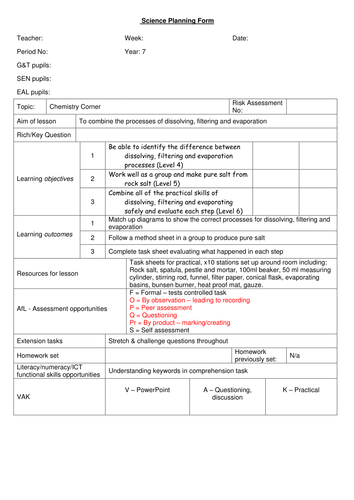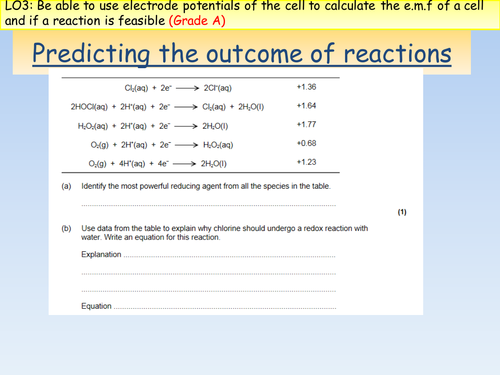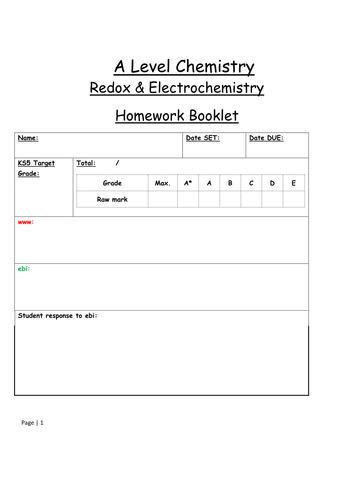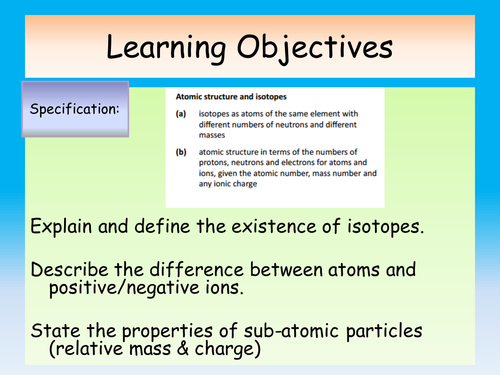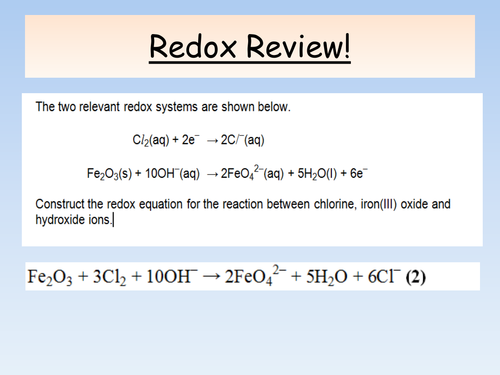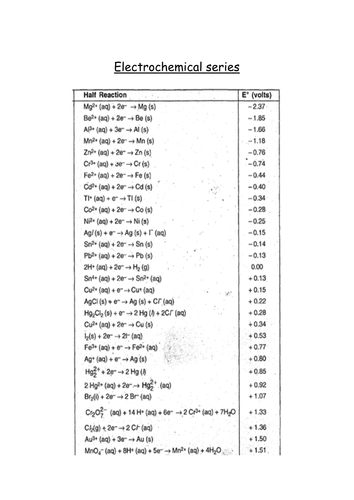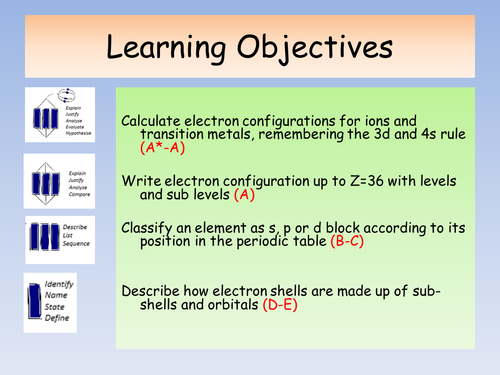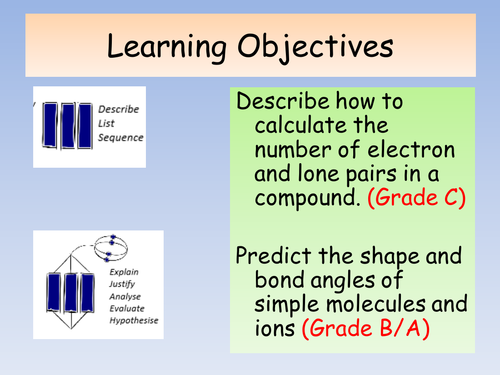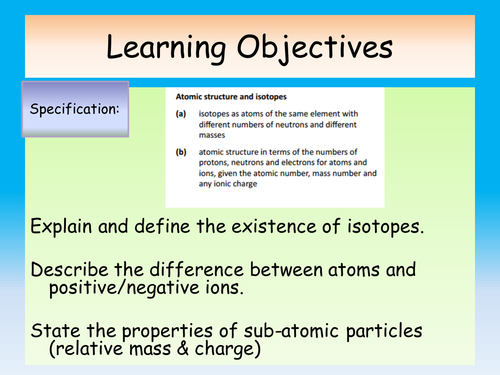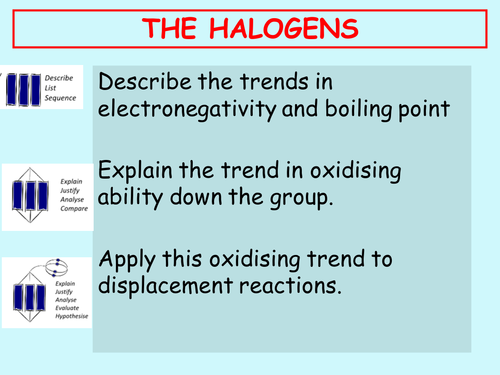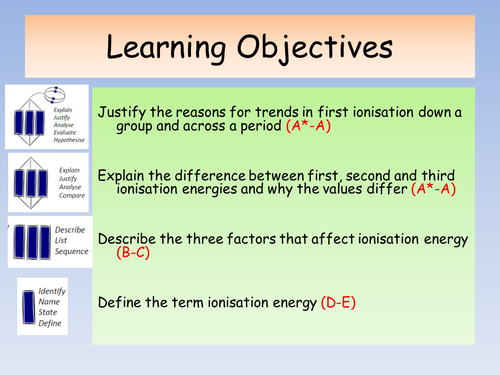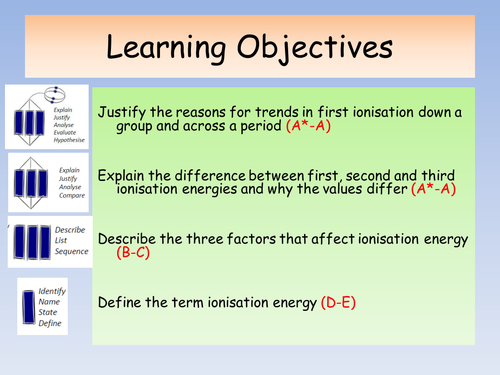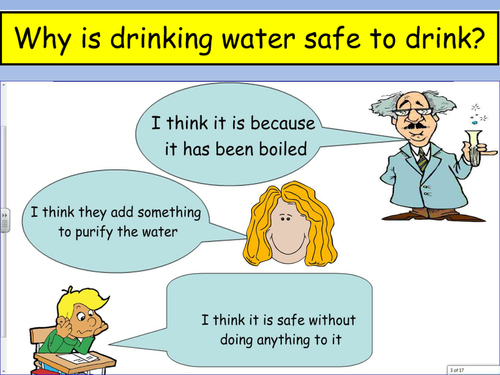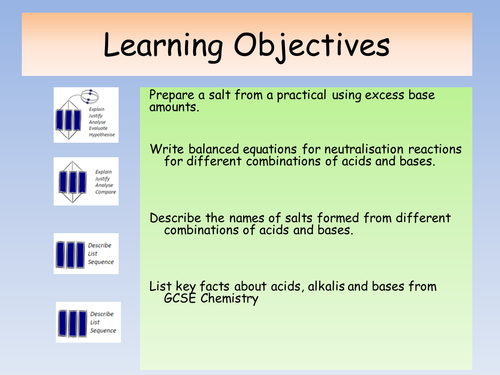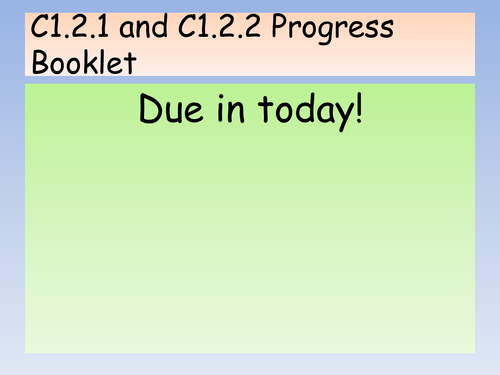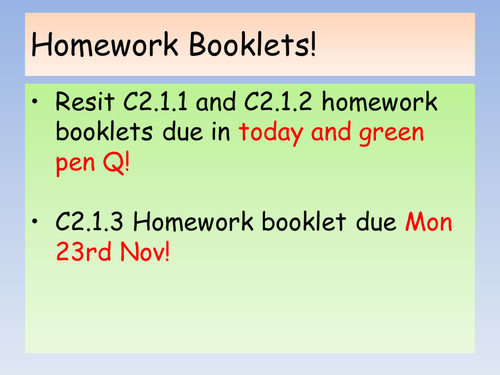
50Uploads
22k+Views
8k+Downloads
All resources

Chemistry Corner KS3 Year 7 Topic - Evaporation
This is the eleventh lesson in a topic I made called Chemistry Corner for KS3 Year 7.
This lesson includes a powerpoint on identifying dissolving, filtering and evaporation techniques from diagrams, what happens in evaporation and then a final group practical. This is a rock salt challenge so students are assessed on their group practical skills as well as their answers to the evaporation questions.
This scheme of work was made when KS3 Levels were used, so you may need to amend the levels according to your own assessment criteria used for KS3.

New AQA A level Chemistry Specification - Carboxylic Acids & Esters Lesson
This powerpoint would cover easily 2 lessons worth of content which covers:
IUPAC rules for naming carboxylic acids and esters.
Reactions of carboxylic acids
Forming esters from carboxylic acids and alcohols
Acid & Base Hydrolysis of esters
Mini practical instructions to make test tube esters.
This powerpoint is following the new A Level AQA Specification.

New AQA A Level Chemistry Lesson Fuel Cells
This lesson follows the new AQA A Level Chemistry specification 3.1.11.2
The lesson covers:
Recap on predicting if a reaction is feasible based on emf values
Exam question on predicting if a reaction is feasible
Examples of reversible and non reversible reactions and writing overall equation and calculating overall emf values.
Comparing advantages and disadvantages of reversible and non reversible fuel cells
Hydrogen oxygen fuel cell, youtube clips, how it works and equations
Hydrogen oxygen fuel cell diagram can be printed to A3 and annotated.
Advantages and disadvantages of hydrogen oxygen fuel cell

New AQA A Level Chemistry Electrochemistry Assessment booklet
This assessment booklet follows the new AQA A Level Chemistry specification 3.1.11
This can be used as either a homework booklet to accompany the topic or set as an end of topic assessment booklet. I used it as a homework booklet and it comes with a front cover sheet with room for www and ebi comments and mark scheme.
Extra exam questions have also been uploaded for this topic as well.

OCR A Level Chemistry A New Spec (from Sept 2015) - Atoms and Reactions whole topic
First topic in Module 2 - Foundations in Chemistry. All lessons fully resourced with powerpoints, worksheets progress sheet of the whole topic, AfL task on development of the atom and homework booklet with markscheme. I hand out the homework booklets at the start of every topic and collect in at the end to mark using www and ebi. The homework booklet questions have been sourced from the end of Chapter questions within the OCR textbook and typed up as no electronic copy was available. The mark scheme corresponds to the OCR pages in the textbook as well.
This is the first topic going from 2.1-2.1.2 according to the OCR Specification.
SOLO symbols are used to differentiate between tasks. Hope you find it useful and please let me know of any suggestions or improvements. More topics to follow!

New AQA A Level Chemistry - Redox and Introduction to Electrochemical Cells
This lesson follows the new AQA A Level Specification Electrode Potentials and Cells 3.1.11.1
The lesson content covers:
Electrochemical cells and the role of the salt bridge
Daniell Cell Practical sheet (can be used as required practical 8)
Large cell diagram can be printed onto A3 and labels added
How to calculate electrode potentials
How to draw conventional representations of cells

New AQA A Level Chemistry Electrochemical Series and Standard Hydrogen Electrode
This lesson follows the new A Level AQA Specification 3.1.11.1 on Standard Hydrogen Electrode and Electrochemical Series
The lesson covers:
The role of the SHE
How changing conditions can affect electrode potentials
Electrochemical series and trends
Predicting if a reaction is feasible based on electrode potentials

OCR A Level Chemistry A New Spec (from Sept 2015) - Electron structure lesson
This is the first lesson in the Electrons, bonding and structure topic in Module 2 - Foundations in Chemistry.
The powerpoint is long and will probably take 2-3 lessons based on the ability of the class! It covers GCSE concept of electron shells compared to sub-levels, orbitals, rules for filling, short hand configurations and deciding on the blocks in the periodic table.
I have included my tip on how to best illustrate energy levels, sub-levels and orbitals in a diagram drawn on the board if you check the notes at the bottom of the slide!

OCR A Level Chemistry A New Spec (from Sept 2015) - Shapes of molecules lesson
This is lesson 4 in the Electrons, bonding and structure topic in Module 2 - Foundations in Chemistry.
The powerpoint covers bonding pairs vs lone pairs repulsion, drawing simple shapes and a rule list for helping determine how many LP and BP and therefore what shape is produced. It also goes onto multiple bonds. I encourage the use of molymod kits for this lesson too, which helps with the 3D aspect of bonding.

OCR A Level Chemistry A New Spec (from Sept 2015) - Electronegativity and IMF lessons
This is lesson 5 and 6 in the Electrons, bonding and structure topic in Module 2 - Foundations in Chemistry.
There is enough content here to easily last 2-4 lessons depending on the ability of the class!
The powerpoint starts off with a bonding pop quiz to test their recall of drawing shapes, names and bond angles then goes onto electronegativity, polar and non polar bonds.
The following lesson then covers London forces, permanent dipole-dipole and hydrogen bonding and applying this to properties of water. There is also an AfL task which I set the students at the end to consolidate their understanding of intermolecular forces and looking at case studies of iodine, water and DNA.

OCR A Level Chemistry A New Spec (from Sept 2015) - Atoms intro lesson
First lesson I use as an introduction to A Level Chemistry as part of Module 2 - Foundations of Chemistry.
It is a great group based lesson to encourage discussion about recapping ideas from GCSE including:
Labelling an atom
Atomic numbers
Numbers of sub-atomic particles in atoms and ions
Isotopes

OCR A Level Chemistry A New Spec (from Sept 2015) - Titration and Concentration lesson
This is the fifth lesson in the Amount of Substance topic in Module 2 - Foundations in Chemistry.
The powerpoint covers calculating concentration review and mass concentrations and then goes onto how to read from a burette and my titration top tips! The students then have to perform a titration and try and get concordant results in order to calculate the concentration of hydrochloric acid using a standard solution of sodium hydrogen carbonate.
There are questions on the practical sheet which structures the calculations with model answers on the teacher sheet.

OCR A Level Chemistry A New Spec (from Sept 2015) - The Halogens lessons
There are 4 lessons here covering the whole The Halogens, 3.1.3 in the OCR specification.
Lesson 1 covers - Physical trends of the Halogens and displacement reactions. There is a teacher and student practical sheet included.
Lesson 2 covers - Halide ion tests including a teacher and practical sheet.
Lesson 3 covers - Disporportionation and the uses of chlorine including an ethical discussion using greenpeace and WHO articles for a literacy task.
Lesson 4 - PAG 4.2 Teacher and student worksheets

OCR A Level Chemistry A New Spec (from Sept 2015) - Periodicity lessons
These are two lessons covering 3.1.1 from the OCR specification on Periodicity.
The first powerpoint covers Ionisation energies, equations, factors affecting ionisation energies and lots of graph and trend interpretation exam questions throughout.
The second lesson is an AfL task which I set to compare the properties of diamond, graphite, silicon dioxide and graphite. An information sheet is provided to help with diamond and graphite information. I set this task as a homework/in class task to include watching a TED clip on graphene.

OCR A Level Chemistry A New Spec (from Sept 2015) - Periodicity and Reactivity Trends whole topics
This bundle of resources covers:
3.1.1 Periodicity
3.1.2 Group 2
3.1.3 The Halogens
3.1.4 Qualitative Analysis
The resource includes powerpoints for every lesson, practical activities including teacher/technician sheets, exam questions, mark schemes as well as the homework booklet and mark scheme covering these topics.
I hand out the homework booklet at the start of the topic (e.g. start of Periodicity) and collect it in at the end of the topic (Qualitative Analysis). The questions have been typed up from inside the OCR textbook as no electronic copy was available.
We use SOLO symbols to differentiate between different levels of progress.
Please let me know any feedback or improvements. More units to follow!

OCR A Level Chemistry A New Spec (from Sept 2015) - Disproportionation and uses of chlorine lesson
This is the third lesson in the Halogens topic 3.1.3 in the OCR Specification.
The powerpoint covers what disproportionation means, reactions of chlorine in water and the ethical uses of chlorine in water. There is an exam question and mark scheme to assess learning but there is also a literacy based task with articles from Greenpeace and WHO to compare the ethical uses of chlorine in water.

OCR A Level Chemistry A New Spec (from Sept 2015) - Acids and Redox whole topic
Third topic in Module 2 - Foundations in Chemistry. All lessons fully resourced with powerpoints, worksheets progress sheet of the whole topic, PAG worksheets, multiple choice assessment and homework booklet with markscheme. I hand out the homework booklets at the start of every topic and collect in at the end to mark using www and ebi. The homework booklet questions have been sourced from the end of Chapter questions within the OCR textbook and typed up as no electronic copy was available. The mark scheme corresponds to the OCR pages in the textbook as well.
This is the whole topic for Acids and Redox fully resourced 2.1.4-2.1.5 according to the OCR Specification.
I have included the 10 for 10 (10 qs in 10 mins) which is a multiple choice summative assessment I used after I taught 2.1.1-2.1.5 to get the students used to multiple choice questions and assess their progress. The answers are at the back of the test.
SOLO symbols are used to differentiate between tasks. Hope you find it useful and please let me know of any suggestions or improvements. More topics to follow!

OCR A Level Chemistry A New Spec (from Sept 2015) - Electrons, Bonding and Structure whole topic
2.2 topic in Module 2 - Foundations in Chemistry. All lessons fully resourced with powerpoints, worksheets and homework booklet with markscheme. I hand out the homework booklets at the start of every topic and collect in at the end to mark using www and ebi. The homework booklet questions have been sourced from the end of Chapter questions within the OCR textbook and typed up as no electronic copy was available. The mark scheme corresponds to the OCR pages in the textbook as well.
This is the whole topic for Electrons, Bonding and Structure fully resourced 2.2.1-2.2.2 according to the OCR Specification.
SOLO symbols are used to differentiate between tasks. Hope you find it useful and please let me know of any suggestions or improvements. More topics to follow!

OCR A Level Chemistry A New Spec (from Sept 2015) - Determination of Formulae lesson
This is the second lesson in the Amount of Substance topic in Module 2 - Foundations in Chemistry.
The powerpoint covers empirical and molecular formula, relative molecular mass, hydrated salts and water of crystallisation.
The worksheets will help with empirical formulae calculations (there is a help sheet if needed for weaker students) however there is also a stretch and challenge task on Ions for higher ability students to complete to differentiate.
The practical activity helps bring together empirical formula and water of crystallisation but also helps prepare students for PAG 1.3 prior to them completing their first PAG.

OCR A Level Chemistry A New Spec (from Sept 2015) - Moles, volumes and concentration lesson
This is the fourth lesson in the Amount of Substance topic in Module 2 - Foundations in Chemistry.
After PAG 1.3 has been performed I teach this lesson. The powerpoint covers moles, volume and concentration calculations and re-arranging the equations. converting between units and making up a standard solution using equations.
The worksheets help practice equation and calculation practice and there is a practical sheet for making up a standard solution for students and teachers.

